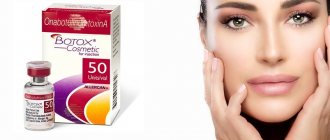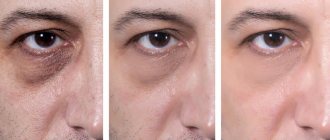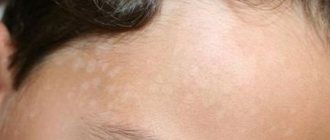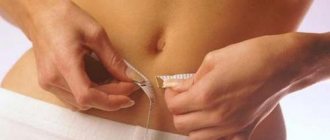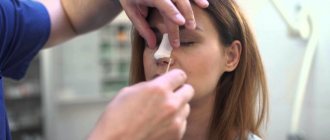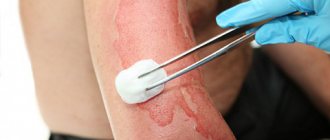What it is?
In medical terminology, the concept of hematoma refers to the accumulation of blood in the soft tissues (in liquid or coagulated form), which was formed as a result of rupture or damage to blood vessels. After an intramuscular injection, a small hematoma may also form in the buttock area, which is not particularly dangerous, but can be very painful.
It manifests itself in the form of a bruise that appears at the injection site. Over time, the bruise begins to “bloom”, from blue to purple, yellow and then disappears. We will consider the reasons for the occurrence of such hematomas, as well as recommendations for quickly getting rid of them.
What happens to the face after mesotherapy
Mesotherapy is a rejuvenating procedure during which medicinal solutions are injected under the skin. Cocktails with beneficial substances, vitamins, hyaluronic acid and other nutrients are often used, which provide deep restoration of the skin and also treat the epidermis.
When performing mesotherapy, you can achieve the following positive effects:
- The therapy reduces wrinkles, scars and scars;
- Improving complexion, this procedure returns a healthy glow;
- Complete relief from acne, acne, pimples;
- Tightening the face shape, eliminating the double chin and jowls;
- The procedure helps get rid of age spots, post-acne, and redness.
It is worth noting! After the introduction of mesotherapy cocktails, the activity of active and reflexogenic points is activated, which is what has a positive effect on the overall appearance. After this, the face becomes well-groomed and young. In this case, there is a risk of hematomas and bruises.
The mechanism of hematoma formation after an injection
A bruise after an injection in the buttock can appear when the needle in the muscle touches a blood vessel. You can understand that damage to the vessel has occurred by feeling a strong burning sensation at the injection site during the injection. In such cases, after the manipulation, a lot of blood often remains on the cotton wool.
The very reason for the occurrence of bruises and hematomas after injections is that blood from the damaged vessel begins to flow into nearby tissues and freezes there. Another cause of bruising may be too rapid intramuscular administration of the drug. In this case, the injected drug does not have enough time to distribute evenly in the soft tissues. A quickly administered medicine creates pressure, under the influence of which nearby small vessels burst. Frequent damage to small blood vessels can also cause the appearance of a hematoma after an injection, when the injection is constantly given in the same place.
Prevention
Treatment should begin with identifying the root cause. By eliminating the cause, you will also get rid of the consequences. If you are just about to undergo a course of injections, it will be useful to familiarize yourself with the safety rules.
To prevent bruises from forming, certain measures should be taken. The hand should be as relaxed as possible while inserting the needle under the skin. To avoid bruising, the injection should not be administered too quickly, but not too slowly.
Immediately after the injection, you should press a cotton swab soaked in an alcohol solution to the injection site and hold it for at least 5 minutes.
You need to use quality needles. The nurse must open the syringe package in front of you; reuse is unacceptable. Don't ask your friends to give you injections. This may be dangerous to your health. This should be done by a professional.
Before the course of injections, you can start taking medications for some time that help strengthen the walls of blood vessels. These medications can be purchased at a pharmacy on the recommendation of a doctor.
People who have ever had a course of injections know that quite often the impact of a syringe needle on the body is accompanied by the formation of bruises after injections. Hematomas are formed due to damage to blood vessels that allow a small amount of blood to pass into the surrounding tissue. The shades of bruises formed from injections can be varied: blue, lilac, violet, even black. As the bruises dissolve, they change color, become greenish, and then yellow. Of course, it is unpleasant to observe such multicolored colors on the body, so many people rush to use special means that can quickly reduce such “decorations” to a minimum.
If the swelling after the injection does not progress, the injection site is simply slightly denser, then this phenomenon does not pose any danger to people. Much more serious is the occurrence of severe painful sensations when the lump at the injection site increases significantly in size, shooting, throbbing pain appears, severe itching, and swelling at the injection site increases. If even some of the above dangerous signs appear, you should not self-medicate or expect spontaneous relief from this problem. Contact your doctor immediately. Such negative consequences of injections can lead to the formation of fistulas, the development of osteomyelitis, extensive abscess, and other purulent complications.
To get rid of hematomas caused by injections, the most reasonable thing is to use an ordinary iodine mesh. At the injection site, draw it 3-4 times a day, provided there is no individual intolerance to iodine.
There is a wonderful thing that has been tested over the years and can significantly improve the condition of problems that arise after injections. You need to mix a tablespoon of natural bee honey with a teaspoon of grated horseradish, add an egg yolk, a small amount of any vegetable oil. Mix the composition thoroughly, add flour, knead the dough, make a flat cake that needs to be applied to the resulting hematoma. Secure the cake with a fixing bandage and leave it overnight. This effective compress helps very well with bruises after an injection and helps to get rid of them as quickly as possible.
Also a well-known folk remedy that can significantly reduce the inflammatory process after injection is a cabbage leaf, which should be beaten a little to obtain cabbage juice. A thin layer of natural bee honey is applied on top of a cabbage leaf and applied to the hematoma. Then the compress is covered with polyethylene and secured with a tight bandage overnight.
To get rid of bruises that appear after injections, you can use a compress prepared with one part regular vodka, one part Dimexide, four parts water. Pre-treat the area where you want to place the compress with a rich cream. Then apply a napkin soaked in the prepared composition to the injection site, cover the top with polyethylene, and secure with a tight bandage. Leave it on all night. By using this compress for several days in a row, you can achieve complete and complete relief from the bruise acquired after the injection.
An ordinary freshly picked burdock leaf, which is immersed in hot water for a few seconds, has a good effect. Next, you need to grease one side of the burdock leaf with a thin layer of bee honey, apply the honey side to the injection site, secure with a bandage, and leave overnight. This simple compress should be repeated for several days until the bruise is completely gone.
Special ointments purchased at the pharmacy - “Traxevasin”, “Heparin” - are excellent for getting rid of bruises received from injections. You can use the well-known "". The creams “Bruise-Off”, “Rescuer”, “Ambulance” have an excellent effect.
There are many remedies that can help with the problem of bruising from injections. Everyone will be able to determine the most suitable remedy. If the bruises formed after the injections do not cause much concern, you do not need to do anything; they will go away on their own.
A bruise after an injection forms when the tissue around the vessel is injured during the injection, and the vessel itself is also inevitably damaged. But the volume of the hematoma may vary, since the vascular wall of each person is individual. Each person has their own indicators of elasticity and permeability. This can be affected, for example, by a lack of certain vitamins (a lack of vitamin C greatly increases the permeability of the vessel). Also, the more elastic the wall, the better it envelops the needle during the procedure, and the more “tight” the injection is. The collagen and elastic fibers that make up the vessel are responsible for elasticity. Often, especially with connective tissue deficiency, their number is quite small. In any case, it is ugly and sometimes painful.
A hematoma after an injection can manifest itself in the form of a banal superficial bruise, or if the vessel is severely damaged, blood pours into the intermuscular, intertissue space and can have a large volume. And this, in turn, can lead to complications, for example, purulent-septic ones.
There are situations when no amount of qualifications and thoroughness can save a person from bruises, bumps and hematoma at the injection site.
Why is this happening?
- If a vessel is accidentally damaged by an injection, blood spills into the intercellular space, forming clots there that gradually dissolve.
- The tissue surrounding the vessel is injured when constant injections are carried out for a long time. Scars form on the vessel, which cause blood to leak from the vessel into the tissue. In this case, not only bruises, but also bumps are formed.
- Rupture of the tissue around the vessel due to the fact that during the injection some of the medicine leaks out. In addition to the hematoma, in this case tissue compaction also forms.
- If blood clotting is poor, blood leaks into the wound from the needle. Sometimes hemorrhages can be significant.
- Large hematomas can appear when a vein is punctured through the vein.
- Thrombosis of a needle or a small vein may occur, which, in turn, creates certain technical difficulties during the procedure.
All lumps and hematomas usually have some degree of pain. This, in turn, increases pain during subsequent injections.
How to reduce the risk of hematoma?
To minimize the likelihood of a bruise after an injection, after the injection you should firmly press a cotton swab with alcohol onto the puncture site and hold it there for several minutes. If the vessel has been damaged, such manipulation will prevent the blood from spreading into the soft tissues and will stop the bleeding from the damaged vessel. The person giving the injection should not administer the drug too quickly, even if the injection is completely painless and the drug is well absorbed.
After the injection, the injection site can be massaged for several minutes, this will facilitate the uniform distribution of the injected drug and minimize rupture of small vessels under its pressure. If a fresh bruise from a previous injection is clearly visible on the buttocks, it is highly undesirable to give a second injection in the same place.
Heparoid Zentiva
An effective ointment for resolving cones after injections has excellent reviews from doctors and patients. It helps eliminate hematomas in a short time. The drug Heparoid Zentiva has the following characteristics:
Antithrombotic, absorbable, anti-inflammatory.
Hemorrhoids, bruises, trophic ulcers, bruises after injections, thrombophlebitis, acceleration of wound healing.
Apply twice a day with an interval of 5 hours, rubbing in with massage movements.
Hemophilia, pregnancy, thrombocytopenia, lactation.
Redness, skin rashes, itching.
Quickly absorbed and has a healing effect
Do not use simultaneously with ointments containing salicylic acid or hydrocortisone.
What do doctors recommend to eliminate hematomas?
In traditional medicine, there are several ways to get rid of a hematoma after an injection. One of the most popular means used for these purposes is an iodine mesh.
Iodine has the property of warming tissue, which in the case of a hematoma accelerates its resorption. To prevent burns, iodine is not applied in a continuous stripe, but in the form of a mesh. This procedure can be repeated up to 4 times during the day. You can warm a bruise from an injection using a home heating pad, which should not be too hot.
To treat hematoma after injections in the buttock, you can also use special ointments that contain troxerutin or heparin. These components thin the blood, which promotes faster resorption of hematomas. Also, drugs containing heparin and troxerutin, after application, increase local blood circulation and eliminate swelling.
It is believed that a solution of magnesium sulfate, which can be purchased without a prescription at any pharmacy, can help with a hematoma after an injection. To do this, a small cotton swab is moistened in this solution and fixed at the site of the bruise with an adhesive plaster overnight.
To speed up the resorption of the hematoma, semi-alcohol compresses can be used. To prepare them, medical alcohol is diluted with warm boiled water in a 1:1 ratio. Soak gauze in the resulting mixture, apply it to the site of the hematoma, cover it with film and attach it with a band-aid overnight.
Medicines
The simplest solution in the fight against bruises from injections is to purchase ready-made pharmaceutical products that are used externally and help to quickly remove subcutaneous hematoma and relieve swelling. These are Vishnevsky ointment, Heparin ointment and Troxevasin gel, which have a resolving effect. They can be used independently for small hematomas.
But if the appearance of a bruise is accompanied by redness, itching, pain and fever, consulting a doctor is essential.
These symptoms signal the danger of developing a large abscess, sepsis, and other purulent complications at the site of compaction.
Vishnevsky ointment
Vishnevsky ointment has a pronounced antiseptic, anti-inflammatory and absorbable effect. It perfectly heals wounds, dissolves dried blood and restores diseased cells. The birch tar included in its composition increases blood circulation and improves the nutrition of soft tissues.
Using this ointment for bruises after injections is simple: just apply a small amount of the drug on a cotton pad or gauze folded in several layers and apply to the area of the hematoma for 2-3 hours. You can carry out 2-3 such manipulations per day. For fixation, use an adhesive plaster or fabric bandage.
Important information: What ointment (cream) to treat bruises in children and what product to apply to a baby’s hematoma
Heparin ointment
Some patients are interested in what can be used to smear large bruises from injections and IVs. In these cases, Heparin ointment is preferable.
Low cost and good effectiveness make it the most popular in the fight against hematomas caused by various circumstances.
It contains nicotinic acid, which ensures vasodilation and rapid penetration of active components.
The ointment is applied 2 times a day (morning and evening) for 3-4 days.
Gel Troxevasin
One of the good options for treating bruises from injections is Troxevasin gel. It is practically odorless, absorbs well and quickly begins to act, providing an anti-edematous, anti-clotting and anti-inflammatory effect.
The active ingredients of Troxevasin strengthen capillaries, increase their elasticity and tone, which leads to the healing of damaged vessels. The gel is applied 2-3 times a day, it is well tolerated even by small children and does not have a systemic effect. The course of therapy can be 10-14 days.
Traditional medicine tips
In folk medicine, there is a lot of advice on how to remove a hematoma after injections. Thermal heating methods are most often used. For these purposes, honey is used, from which unique compresses are prepared. Take 1 tsp. thick honey, heat it in a water bath. Add 1 yolk and a small spoon of butter, mix everything thoroughly and apply the resulting mixture to the bruise. Cover with film, fix with adhesive tape and leave for several hours or overnight.
Many have heard about the use of cabbage leaves in folk medicine to reduce hematoma after an injection. Despite the fact that this method may seem a little strange, sometimes even medical staff recommend its use for patients with bruises after injections. It is believed that cabbage juice has a powerful absorbent effect. You need to take a leaf of fresh cabbage and cut it in several places so that the juice begins to drain well. The cut sheet is placed on the site of the hematoma, covering it on top with cling film, a piece of cellophane or thick cloth. This compress can be left overnight.
How dangerous is a hematoma?
If the hematoma is too painful and even prevents a person from walking, he can consult a doctor (therapist or surgeon), and if necessary, he will be prescribed physiotherapeutic procedures (UHF). A hematoma after an injection does not pose a danger to a person’s life. Usually it goes away completely, like a regular bruise, in 1.5-2 weeks. All of the above methods for getting rid of bruises can speed up this process, but they can only be used if there is no redness or itching around the injection site.
Itching and redness most often indicate the presence of an allergic reaction to the injected drug, and if you start to warm up the area, the allergy can only intensify. In this case, it is recommended to seek advice from the doctor who prescribed the drug.
Hematomas may be accompanied by dense formations and lumps under the skin. They also do not pose any particular danger and indicate that the injected drug is poorly absorbed. In rare cases, they can have more serious consequences and provoke the development of an abscess.
Causes of bruises on the butt
Bruises and hematomas occur in humans as a result of damage to the integrity of blood vessels. Most often this happens during mechanical impact - bruise, blow. However, the presence of bruising is noted during injection therapy.
Why do people get bruises from injections? Experts identify several factors for this phenomenon.
Factors:
- Incorrectly selected needle. A short needle does not allow the medication to be delivered to the muscle layer; it remains in the adipose tissue and is not absorbed there. Failure to fully insert the appropriately sized needle will produce a similar result. A painful lump forms at the injection site.
- Tense muscles. Bruises from injections on the butt often occur due to tightly compressed muscles. The person is afraid of the procedure and instinctively tenses up. As a result, the drug is distributed unevenly.
- Damage to blood vessels during the procedure. Very often the person giving the injection gets into small capillaries. The blood spreads and a hematoma forms. For the same reason, bruises often appear from injections into a vein.
- Prick-pop. This technique involves sharply inserting a needle at an angle of ninety degrees. The syringe plunger is pressed sharply, the medicine is injected quickly and does not have time to be distributed inside, which leads to the appearance of bruises from injections.
- Hematomas on the butt or other area of the body may appear due to allergic reactions to the injected medicine. There is redness of the skin and itching.
- Problems with blood clotting can also cause bruising after an injection.
People of any age and gender are susceptible to this phenomenon. A lot depends on the professionalism of the doctor. It happens that bruises bother you for no reason - find out more.
When should you start worrying and consult a doctor?
You should definitely consult a doctor if a hematoma and lump at the injection site are accompanied by the following symptoms:
- the area around the injection is noticeably red and swollen;
- itching appeared;
- the hematoma or lump underneath it becomes hot to the touch, and pulsation is felt in this place;
- fluid or pus begins to ooze from the puncture site;
- chills appeared, body temperature increased and there was a deterioration in general condition.
Such symptoms may indicate that an infection has occurred. If you do not seek medical help in a timely manner, this can result in the formation of purulent fistulas, abscesses and sepsis. It may even be necessary to open the hematoma and abscess, which is most often performed under local anesthesia.
Prices of pharmaceutical ointments
Absorbable ointments help get rid of lumps under the skin in the shortest possible time. Every home first aid kit should contain at least one of the products discussed. Often the choice of a specific ointment is justified by its price. The average price in pharmacies varies from 30 to 800 rubles.
| Name of the drug, price, rub. | ||||||
| Mederma | Contra-ktubex | Heparin ointment | Troc-sevasin | Lyoton | Badyaga | |
| Gorzdrav | 498,00 | 437,00 | 52,00 | 114,00 | 254,00 | 42,50 |
| Piluli.ru, online pharmacy | 605,00 | 713,00 | 71,00 | 185,00 | 370,00 | 79,00 |
| APTEKA.ru, online pharmacy | 544,00 | 589,00 | 79,00 | 212,00 | 338,00 | 76,00 |
| Vitamin A | 627,00 | 640,00 | 51,50 | 203,00 | 349,50 | 80,50 |
| Dialogue | 532,00 | 467,40 | 46,50 | 136,70 | 278,00 | 59,00 |
| Trika | 526,30 | 468,00 | 34,00 | 143,00 | 335,00 | 70,00 |
| Avicenna Pharma | 633,00 | 449,00 | 39,00 | 149,00 | 297,00 | 59,00 |
Prices for various ointments may depend on the region, the status of the pharmacy and the manufacturer. Absorbable ointments help get rid of lumps under the skin only when used correctly. Before using any product, you should carefully read the package insert.
It is worth remembering that ointments treat lumps that form immediately after an injury. It is advisable that the surgeon exclude dangerous anomalies before purchasing the drug. It will also help you choose the best remedy to eliminate education and its unpleasant consequences.
Author of the article: Shalunova Anna
Article design: Oleg Lozinsky
Hematoma after intravenous injections
A bruise can also occur after the drug is injected into a vein. A hematoma after an intravenous injection has almost the same mechanism of occurrence as a hematoma that occurs with an intramuscular injection. It appears when a vein is damaged by a needle and subsequent leakage of blood into the soft tissue. A hematoma may also appear after intravenous blood is taken for testing. To avoid this phenomenon, after the injection it is necessary to press the cotton wool tightly to the puncture site, bend your arm strongly at the elbow and hold it in this position for several minutes.
Often a hematoma appears when drugs are administered using a dropper. A bruise is guaranteed to occur when the needle comes out of the vein and the drug accumulates in nearby tissues. It puts pressure on weak local vessels, they burst and can cause a fairly large hematoma.
Treatment of hematomas on the face
Since childhood, each of us remembers that if there is a bruise, it is better to apply something cold, then the black eye will be smaller. Ice is your universal assistant. By narrowing the lumen of the capillaries, it prevents the appearance of hematomas and, of course, reduces pain.
It is not recommended to apply ice directly to the damaged area. You should wrap it in cloth. For example, gauze. Direct contact of ice with the lip can cause local frostbite and damage to the delicate epithelium of the lip. This method is not so effective, but it is handy and very convenient.
Your sleep plays a significant role. Namely, how you sleep. Try not to lie down in the first hours after the procedure. After some time has passed, you are allowed to sleep, but just do not forget to put a couple of pillows so that the level of your head is as high as possible.
How to treat a bruise after a vein injection
Almost all methods used to treat hematomas after intramuscular injections are suitable for treating such bruises. The most effective is the use of a semi-alcohol compress at night and the use of ointments and creams containing heparin.
It is not recommended to use the popular iodine mesh to treat bruises after an intravenous injection. As a rule, these injections are made into the veins located on the inside of the arm, in the area of the elbow. The skin in this area is much thinner and more sensitive than the skin on the buttocks. Frequently lubricating this area with iodine mesh can lead to a burning sensation and discomfort.
